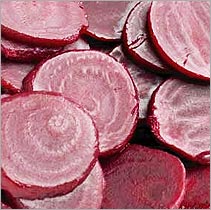Red food coloring refers to the red food color or the red food dye that is used as a food additive in various kinds of edible food products. Colorings are used primarily for enhancing the color of various drinks and foods. Various food products that occur in red color use the natural red color. Natural red food color is extracted from the red beet. Artificial red food coloring is the allura red food dye, which is a red azo dye. Both of these versions of red food dye - the natural red food coloring and the artificial red food dye, allura red - are different in their compositions and obviously differ in their chemical properties and health effects. Let's understand each of these red food dyes in detail, in terms of their usage and properties.
Natural Red Food Coloring

Natural Red Food Color
The red food coloring is derived from the beet root vegetable. It's color shade varies from deep beet root color that is liked a mix of red and purple shades. The color is mainly due to the presence of a water soluble content betalains. There are two types of betalains that are responsible for the extreme colors ranging from red to deep purple. Betalains are found only in one plant kind category that includes prickly pear cactus, amaranth and chard.
Natural red food dye is nothing but
beet juice color that is extracted from beet root and then sold as a natural food color. It can either be purchased from the market in packaged form, or even extracted at home. To ensure that the home extracted beet root, natural food coloring is not exposed to high temperatures for longer durations. It runs the risk of deteriorating and turns into a yellowish tan color.
Since the natural red food coloring dye does not respond favorably to the changes in the atmosphere, it is best suited to the foods that are kept in the cold atmosphere. It doesn't really go well in confectionery products either. The main food products that use natural red food coloring dye are ice creams, shakes, yogurt desserts, and the similar line of foods.
Artificial Red Food Coloring

Allura Red Food Dye
Artificial red food dye is the is known as allura red AC with C.I. 16035 &
FD&C Red 40. The red food dye has E number E 129. It was discovered as a substitute to amaranth. It is a dark red food dye that is soluble in water, with a melting point more than 300 degrees Celsius. It is usually believed to be derived from an insect, but it is far from the truth. Allura red food coloring is actually made from petroleum.
Allura red food dye is often used a coloring dye in foods like sweets and drink. But it is, like any other synthetic food color, known to cause a set of side effects and health hazards. The main side effects of the allura dye are hyperactivity symptoms in kids, aggravating of asthma and breathing problems, allergy for aspirin related intolerance and bleak risks of causing bladder cancer in animals. Amaranth is also a kind of red food coloring which is quite popular among the food dyes, but mostly allura red is used.
Both the natural red food dye and the artificial red food color have their own distinct properties as well as the limitations, and are therefore used for different purposes and in different food products. But it is any day better to stick to
natural food colors to avoid any kind of ill effects associated with the synthetic food dyes in general.

